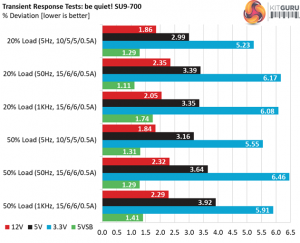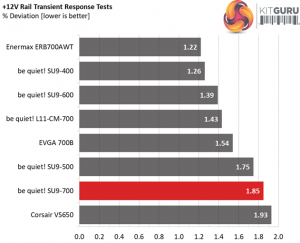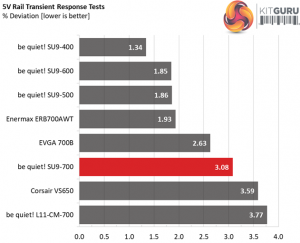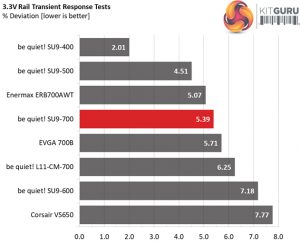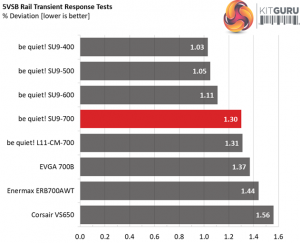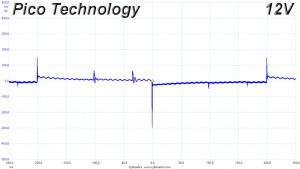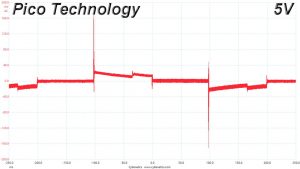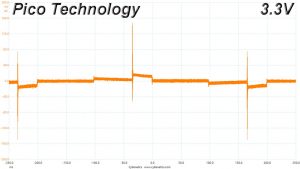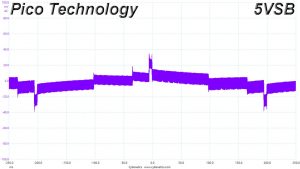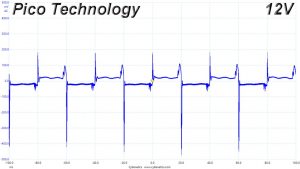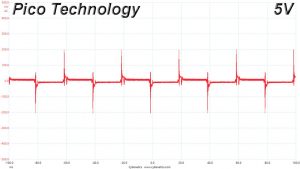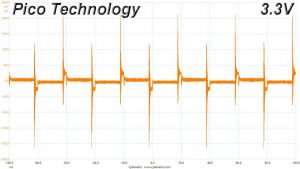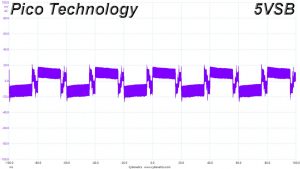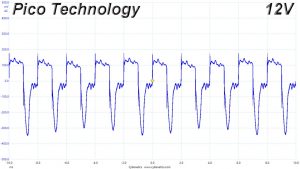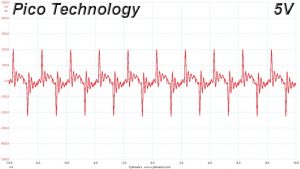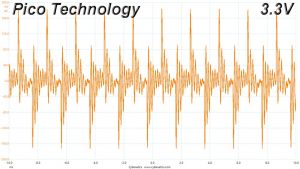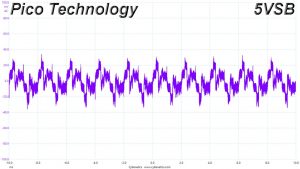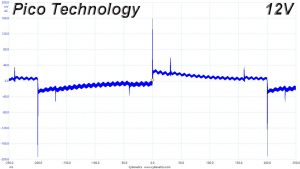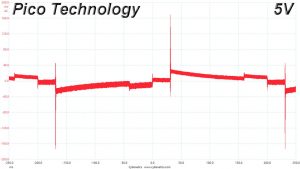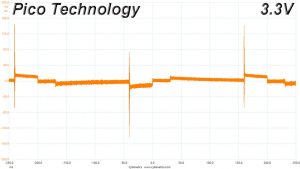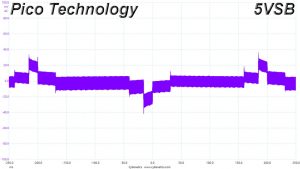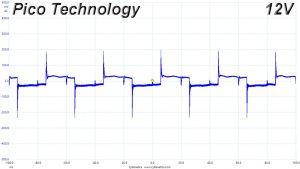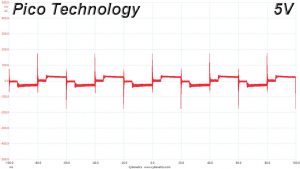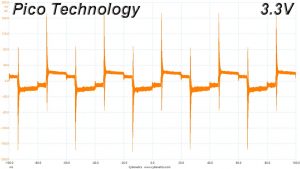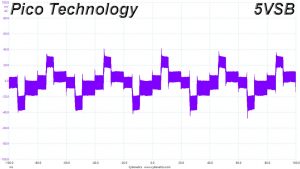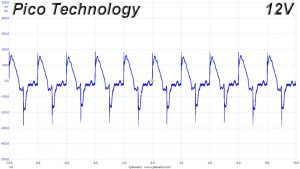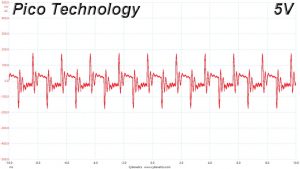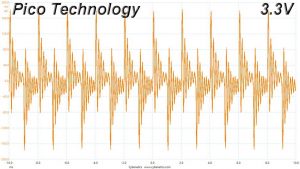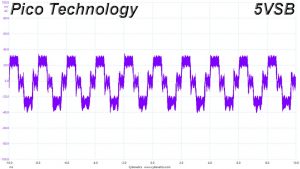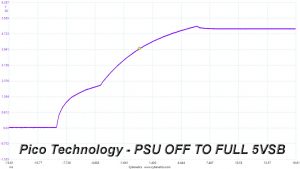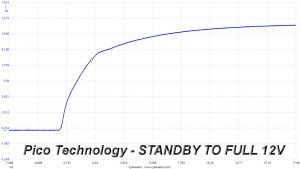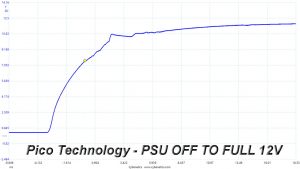Advanced Transient Response Tests
For details on our transient response testing, please click here.
These tests are crucial because they simulate the transient loads a PSU is likely to handle (such as booting a RAID array or an instant 100 percent load of CPU/GPUs). We call these “Advanced Transient Response Tests” and they are designed to be very tough to master, especially for a PSU with a capacity of less than 500W.
In all of the tests, we use an oscilloscope to measure the voltage drops caused by the transient load. The voltages should remain within the ATX specifications regulation limits.
We should note that the ATX spec requires for capacitive loading during the transient rests, but in our methodology we chose to apply the worst case scenario with no extra capacitance on the rails.
Advanced Transient Response at 20 Percent – 200ms
| Voltage | Before | After | Change | Pass/Fail |
|---|---|---|---|---|
| 12V | 12.147V | 11.921V | 1.86% | Pass |
| 5V | 5.012V | 4.862V | 2.99% | Pass |
| 3.3V | 3.308V | 3.135V | 5.23% | Fail |
| 5VSB | 5.051V | 4.986V | 1.29% | Pass |
Advanced Transient Response at 20 Percent – 20ms
| Voltage | Before | After | Change | Pass/Fail |
|---|---|---|---|---|
| 12V | 12.147V | 11.862V | 2.35% | Pass |
| 5V | 5.012V | 4.842V | 3.39% | Pass |
| 3.3V | 3.308V | 3.104V | 6.17% | Fail |
| 5VSB | 5.052V | 4.996V | 1.11% | Pass |
Advanced Transient Response at 20 Percent – 1ms
| Voltage | Before | After | Change | Pass/Fail |
|---|---|---|---|---|
| 12V | 12.148V | 11.899V | 2.05% | Pass |
| 5V | 5.012V | 4.844V | 3.35% | Pass |
| 3.3V | 3.308V | 3.107V | 6.08% | Fail |
| 5VSB | 5.051V | 4.963V | 1.74% | Pass |
Advanced Transient Response at 50 Percent – 200ms
| Voltage | Before | After | Change | Pass/Fail |
|---|---|---|---|---|
| 12V | 12.106V | 11.883V | 1.84% | Pass |
| 5V | 5.005V | 4.847V | 3.16% | Pass |
| 3.3V | 3.299V | 3.116V | 5.55% | Fail |
| 5VSB | 5.021V | 4.955V | 1.31% | Pass |
Advanced Transient Response at 50 Percent – 20ms
| Voltage | Before | After | Change | Pass/Fail |
|---|---|---|---|---|
| 12V | 12.106V | 11.825V | 2.32% | Pass |
| 5V | 5.005V | 4.823V | 3.64% | Pass |
| 3.3V | 3.299V | 3.086V | 6.46% | Fail |
| 5VSB | 5.021V | 4.956V | 1.29% | Pass |
Advanced Transient Response at 50 Percent – 1ms
| Voltage | Before | After | Change | Pass/Fail |
|---|---|---|---|---|
| 12V | 12.106V | 11.829V | 2.29% | Pass |
| 5V | 5.005V | 4.809V | 3.92% | Pass |
| 3.3V | 3.299V | 3.104V | 5.91% | Fail |
| 5VSB | 5.021V | 4.950V | 1.41% | Pass |
The results above are quite disappointing to see. The transient response tests are the most important since they provide with great accuracy, the PSU's response under real life scenarios where the load is not steady but it constantly changes. The +12V rail's deviation is close to 2% and the 5V exceeds 3%. The 3.3V rail is the worst of all though, and it fails in all of our tests.
Here are the oscilloscope screenshots we took during Advanced Transient Response Testing:
Transient Response At 20 Percent Load – 200ms
Transient Response At 20 Percent Load – 20ms
Transient Response At 20 Percent Load – 1ms
Transient Response At 50 Percent Load – 200ms
Transient Response At 50 Percent Load – 20ms
Transient Response At 50 Percent Load – 1ms
Turn-On Transient Tests
In the next set of tests, we measure the SU9-700’’s response in simpler transient load scenarios—during its power-on phase.
For our first measurement, we turn the PSU off, dial in the maximum current the 5VSB rail can handle, and switch the PSU back on.
In the second test, we dial the maximum load the +12V rail can handle and start the PSU while it is in standby mode. In the last test, while the PSU is completely switched off (we cut off the power or switch the PSU off through its power switch), we dial the maximum load the +12V rail can handle before restoring power.
The ATX specification states that recorded spikes on all rails should not exceed 10 percent of their nominal values (+10 percent for 12V is 13.2V, and 5.5V for 5V).
We see two small overshoots here, one at 5VSB and the second during the last test. Overall satisfactory performance.
 KitGuru KitGuru.net – Tech News | Hardware News | Hardware Reviews | IOS | Mobile | Gaming | Graphics Cards
KitGuru KitGuru.net – Tech News | Hardware News | Hardware Reviews | IOS | Mobile | Gaming | Graphics Cards


